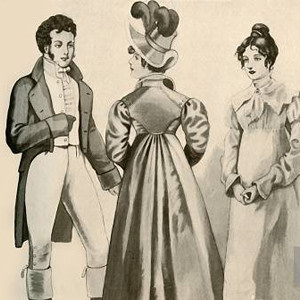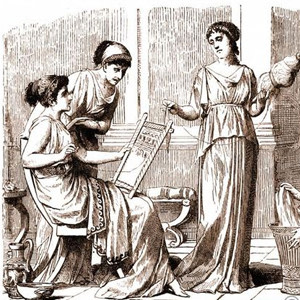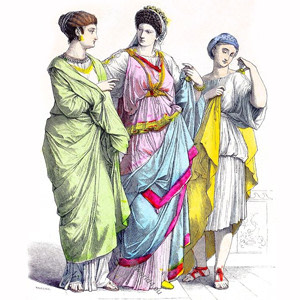History of American Costume

1804
American costume worn during the french empire was known as "Empire Line". During 1700, long coats as similar to that worn in Washington by gentlemen who were known as the administrators. 1816
The costume of this period was incomplete without the huge muffler. 1824
The short flared skirt and vest similar to that of "Empire Line". The breadth of the shoulder appears to be short. 1842
A fashionable period introducing the full triple skirt with many petticoat to give different appearance. Another style was also introduced known as elastic type.1850
The nineteenth century, the coat were short with a long skirt. High collars and muslins was the fabric used with silk.The hair style continued to be pleated over the period of years and different hair dresses and hats were introduced.In the seventy's the hop and trial became the common fashion during the 70's and 75's.1873 - 1897
The fashionable dress called "BUSTLE" suceeded the loop. The sleeves continued to be large at the cuff. 1878 skirt with the bodice in one piece with no line at the waist. 1897 skirts of one color a material and the bodice of another color.19th Century
The 19th century was the begining as long trousers, the intro of which was voluntarily opposedby people and it was supported by the Anglo, sexons and dancers.1902
The morning glory skirt, jackets, gloves and sleeves with close fitted.1907
The broad shoulder was attained by trims, the lack yoke or indispencible sleeve attachment.1910
The tailored skirt which was known as bubble skirt. It was trimmed and has gathers around the waist.1914
The silloutes of an evening gown with side panels, a decorative waist band.1915
It is a suite showing a tight waist and full gown.1916
The short skirt succeded the long skirt, close fitted skirts of the early period was given importance to footwear.1920
The popular suit at this time was in grey color. The cap was made of plastic with a harmonsing color. [Yellow-orange, red-violet, green-blue] added the finishing touches towards fashion. The short frock with shoes,sleeveless dress and sailor hat complete the overall look.1936
Fashionable cloth beachwear give different looks and support to the fashion in American costumes.History of French Costume

This time frame from 1789-1825 can be divided into several different sub periods. The first is 1788-1799, the period of french revolution was a sharp transition period. The second is 1800-1815, the time of french empire and was stable neoclassical period. 1815-1825 was the late neoclassical period that showed a gradual shift towards the romantic style.
Late 18th century women's dress collasped from its padded and puffed look to a thin sillouttes. As a french revolution progressed different women styles were adopted that appeared to have reference to the revolutionary politics, social structure and philosophy at the time. In the early 1790's eg. the English or man tailored style was favour. There was a brief fashion for plain dresses in dark colors prior to 1792 but directly took over to French fashion which again went wild trying out fashions in Greek. Sauvage (wild / natural) & Othahead [Tahitian] style, the seudo break was proved as the most popular and adopted as the standard style in Europe in the late 1790's while men's costume in the 1970's also became thinner in line.
It seperated its style from women's soby beginning to lose nearly all forms of surface, decoration,lack and bright color as feminen. This change was slow but it completely altered men's dress by the end of 19thcentury into dull dark uniform dress. Other major changes included the adoptation of trousers from the dress of sailors and the fashion for wings and hair powder. The hat looked like a Greek helmet.The French Revolution had a significant impact on the Fashion Industry and Fashion Designers in France. During the revolution, there was a rejection of the elaborate and extravagant fashion trends of the aristocracy, which were seen as symbols of excess and inequality. The revolutionaries promoted more simplistic and practical clothing styles that reflected the values of the time. Fashion Designers played a role in this shift, as they adapted to the changing trends and created new styles that reflected the ideals of the revolution. Some designers, such as Rose Bertin, who was the dressmaker to Queen Marie Antoinette, were forced to close their businesses due to the revolution's anti-aristocratic sentiments. However, others, like Jacques-Louis David, embraced the revolutionary ideals and designed clothing that reflected the new political and social order.The revolution also had a significant impact on French fashion as a whole. The abolition of sumptuary laws, which regulated what types of clothing people could wear based on their social class, led to a democratization of fashion. People from all classes could now wear more fashionable clothing, and new styles emerged that were accessible to everyone.In addition, the revolution led to a rise in nationalism, which sparked an interest in creating a distinct French fashion identity. This led to the development of styles like the Empire style, which emphasized simplicity, straight lines, and classical motifs.Late 18th century women's dress collasped from its padded and puffed look to a thin sillouttes. As a french revolution progressed different women styles were adopted that appeared to have reference to the revolutionary politics, social structure and philosophy at the time. In the early 1790's eg. the English or man tailored style was favour. There was a brief fashion for plain dresses in dark colors prior to 1792 but directly took over to French fashion which again went wild trying out fashions in Greek. Sauvage (wild / natural) & Othahead [Tahitian] style, the seudo break was proved as the most popular and adopted as the standard style in Europe in the late 1790's while men's costume in the 1970's also became thinner in line.
History of Greek Costume

DARK AGES OF GREESE
| Timespan | Description |
| 800 - 500 BC | Achievement Period |
| 776 BC | Olympic games in Greece |
| 500 - 376 BC | Classical age (Art, Drama, Litrature) |
| 376 - 323 BC | Alexander the Great |
During the period of Greece, came through the prosperous costume. The classical age was one of the most creative ages. Greek philosophers such as Socrates are few among the artist's who contributed to the people's life in different stages.
MATERIALS
Wool and Linen: Linen came into Greece from Egypt. It is imported from the peace on bale that were sold by Egyptian.The color tone remains off white but ordinary people wear dark color such as reddish brown and mustard.MAIN COSTUME
The Greek costumes had a rectangular piece of cloth. This cloth was put on one shoulder adn one arm was left free similarto the Indian shawl. The cloth was tied with a ribbon at the waist and that have over the chest and back.CHITON AND TUNIC
The short unique round belt was a typical dress of Greeks. It was develpoed during the ages and was finally came to the undergarment. This was closed down by a seam line and this garment was then pinned at the shoulder and tied at the waistor hips and drapped in hanging folds. The belt around this made it easy to tuck the pleat or fold of fabrics without a belt.They used to wear tied tunic bags loosely and served as a night garment. When the tunic was of full length it was worn as a costume for festivals. The Chiton was also made sometimes with two pieces of clothes that was stitched lengthwise. It couldbe narrow and close to the body.HIMALTION
It was developed as an early garment. It was a kind of cloth which was made of a single piece of cloth which is 6 feet in length.It was put around the body without fasteners while in many ways it resembles.WOMEN's COSTUME
Greek women since the early time had been using a rectangular piece of cloth and were mostly draped.GOWN
A gown, worn by women is a usually loose outer garment from knee to full-length. Later, gown was applied to any full-length woman's garment consisting of a bodice and attached skirt open along one side. RELIGIOUS COSTUME
The Greek had no special religious costume but hair dress up and footwear were important. The Greek women covered their headeither with a hat or with a modern hairdress. A pointed straw hat shoes were worn by both sexes.Fashion Design has played a significant role in Greek Fashion throughout history. Ancient Greece is known for its iconic clothing styles, such as the chiton, which was a simple garment worn by both men and women. In modern times, Fashion Design in Greece has helped to shape the country's Fashion Industry and it's unique style. Greek Fashion Designers are known for their creativity, use of traditional Greek elements, and incorporation of modern trends. Some prominent Greek fashion designers include Vassilis Zoulias, who is known for his glamorous evening wear, and Mary Katrantzou, who combines bold prints and vibrant colors in her designs. Other designers, such as Angelos Bratis and Yiorgos Eleftheriades, have gained international recognition for their minimalist and modern designs. Fashion Design has also played a role in promoting Greek culture and heritage. Many designers incorporate traditional Greek elements into their collections, such as motifs from ancient Greek art or traditional Greek embroidery techniques.History of Egyptian Costume
Egyptian clothing was filled with a variety of colors adorned with precious gems and jewels. The fashions of ancient Egypt were made for not only beauty but also comfort. Egyptian fashion was created to keep cool in the hot desert. In ancient Egypt, linen was by far the most common textile. It helped people to be comfortable in the subtropical heat. Linen is made from the flax plant by spinning the fibers from the stem of the plant.Royal clothing is particularly well documented, as well as the Khat, nemes, and crowns of the Pharaoh. The Pharaoh would often wear animal skins, usually leopard or lion, as a sign of their status. Men wore wrap-around skirts belted at the waist. This style of dress was consistent across classes, but higher-class Egyptians wore more finely crafted pieces.Women's clothing in ancient Egypt was more conservative than men's clothing. Egyptian women mostly wore a simple sheath dress called Kalasiris. These were held up by one or two straps and were worn down to the ankle, while the upper edge could be worn above or below the breast.The length of the dress denoted the social class of the wearers. Beading or feathers were used as embellishments on the dress. Over the dress, women had a choice of wearing shawls, caps or robes. Children wore no clothing until the age of six. Once they turned six, they were allowed to wear clothing to protect them from the dry heat. Wigs were worn by the wealthy of both sexes. Made from human hair and sometimes supplemented with date palm fiber, they were often styled in tight curls and narrow braids.Jewellery was very popular in ancient Egypt, regardless of social class. It was heavy and rather voluminous. The main reason for wearing jewellery was its aesthetic function. They were quite soberly dressed in white linen fabric, and jewellery offered a possibility for contrast. They used rings, earrings, bracelets, pectoral necklaces, crowns, girdles, and amulets. Ancient Egyptian jewellery was meant to both beautify the wearer and serve as a talisman of power. It was believed to provide power, protection, good luck or guidance through the afterlife and could ward off bad luck or the evil eye.Footwear was the same for both sexes. It consisted of coiled sewn sandals of leather or, for the priestly class, papyrus. The Galabeya has a long-standing tradition in Egypt, worn throughout the country as the national dress. This Galabeya is often covered by a Kaftan, a long piece of clothing that acts as a coat and has long sleeves. The world's oldest woven garment, called the Tarkhan dress, probably fell past the loincloth originally. Slaves and commoners, on the other hand, wore loincloths made from coarse linen or leather. The shendyt was a type of loincloth similar to a skirt. It was a kilt-like garment worn in ancient Egypt.Pharaohs wore a half-pleated kilt with a pleated section in the front, symbolic of their power. They also wore leopard skin cloaks over their shoulders and a lion's tail hanging from their belt to symbolize their status. They also used jewelry and headdresses for special occasions. Ancient Greek Clothing
Ancient Greek Clothing  Ancient Roman Costume
Ancient Roman Costume  Ancient Greek Costume
Ancient Greek Costume Please leave your comments, we do love it!
Most Viewed Articles
Hey, we have amazing content on the latest Fashion, Trends, Style & Creative Arts, and now it's absolutely FREE for you.All you have to do, is just...We always respect your privacy!
Login / Sign-up


